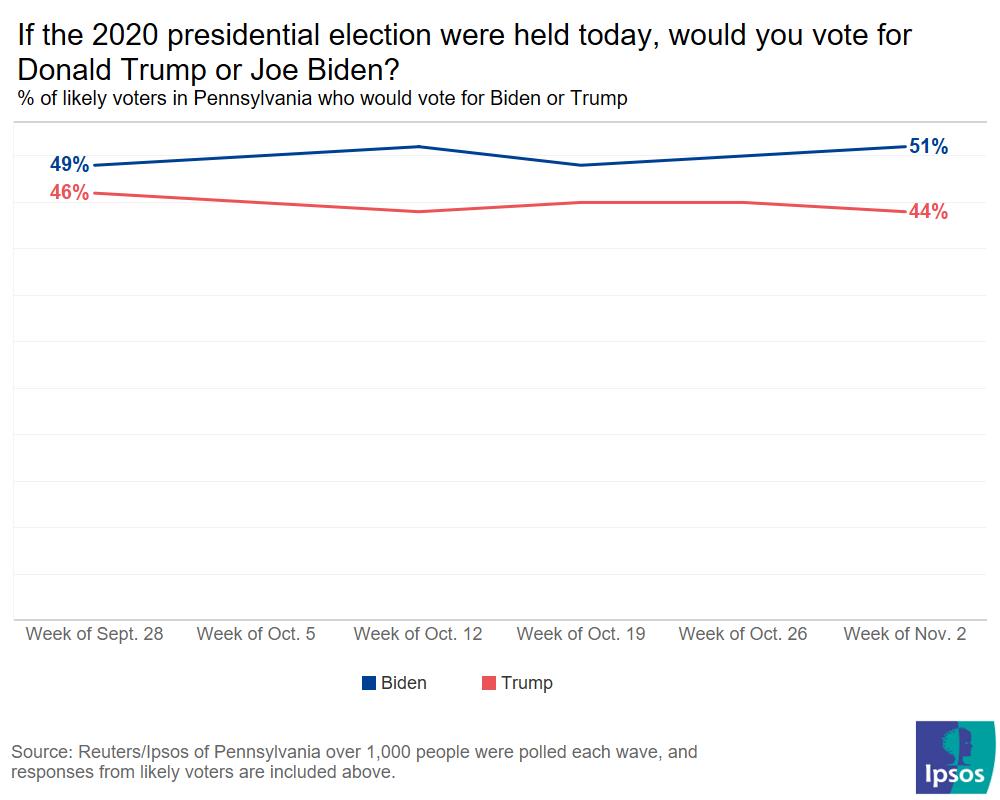What voting looks like in Pennsylvania
Pennsylvania
What you need to know:
- Pennsylvania just rolled out no excuse absentee voting at the end of 2019, meaning its mail in voting infrastructure is largely untested.
- The Supreme Court recently ruled that the state may accept absentee ballots postmarked on November 3rd and received by November 6th.
- Reuters/Ipsos polling finds that Biden has a small edge over Trump though the race has been tight over the past month and a half.
Early voting start date: September 28, 2020
Absentee/Mail voting deadlines: Must be postmarked by November 3rd and must be received by Nov. 6th.
Voter ID: No ID
Party in control of the state legislature: Republican
Governor: Tom Wolf (D)
Secretary of State: Kathy Boockvar (D)
Margins of Recent Races:
2016 Margin: 0.7% for Trump
Mail ballots returned: 2,506,557 as of November 3rd, 2020 at 1:37 PM Election Project
4% of votes cast by mail in 2016

Reuters/Ipsos polling of Pennsylvanians finds that Biden holds a small lead in Pennsylvania in the final days before the election.
Vote history
Do they count votes as they come in or after election day?
Officials cannot begin counting mail in votes until the morning of Election Day, but county election officials aren’t required to begin counting those votes immediately.
Is early voting and wide-scale absentee voting a new thing?
In 2019, Governor Wolf signed a bill that allows all voters to cast an absentee ballot, a measure that went into effect on April 28, 2020 for its primary. Only 4% of votes were cast by mail in 2016, so vote by mail is new for both voters and election officials.
Did they have any problems counting votes in the primary?
Yes, it took about two and half weeks to count the final vote of the two primaries. About 1.4 million people requested mail in ballots in the primary, a historic record that officials struggled to absorb.
Any new laws that expand or restrict people's voting rights?
In addition to expanding vote by mail, that same law extends the voter registration deadline. People can register to vote within 15 days of an election, and voters can request and submit their ballot up to 50 days before an election.
Outside of that, Pennsylvania restored voting rights to formerly convicted felons once they are no longer incarcerated. That does not apply to a person convicted of a felony within the past four years. The Supreme Court ruled on October 28, 2020 that Pennsylvania could extend the deadline which the state can accept ballots from. Mail in ballots may be received by November 6 to be counted.
Pennsylvania has a history of aggressive poll watching. In 2004, Republican poll watchers at the University of Pittsburg challenged the identities of many students waiting to vote. Students then had to get their peers to sign affidavits affirming their identity.
There have been reports of aggressive poll watching in 2020, with reports of the Trump campaign videotaping voters at dropboxes. The Pennsylvania attorney general warned the campaign that those engaging in these activities could risk being charged with voter intimidation.
What will lead to a mail in ballot getting thrown out?
Pennsylvania requires voters to return any ballot in a secrecy envelope. A vote arriving without a secrecy envelope is dubbed a “naked ballot”. The Pennsylvania Supreme Court ruled it cannot be counted and must be thrown out.
Additionally, under the state law, ballot harvesting is illegal; voters can only deposit their own ballots to a voting location or dropbox, unless they are assisting a voter with a disability or who otherwise needs assistance.
Unlike in many other swing states, votes cannot be thrown out based on people’s signature matching the signature the state has on file.
What are rules around a recount?
If the margin of victory is within 0.5%, an automatic recount is triggered. Candidates can also request a recount in the five days following the election.



